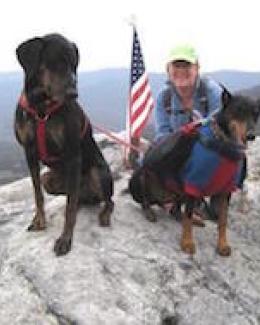One thing the earth does very well is recycle—plants, animals, even us. Living things grow and thrive by taking elements from the earth and the sky, and when they die, those elements are returned. As the Book of Common Prayer puts it, “Earth to earth, ashes to ashes, dust to dust.”
This recycling job falls to microbes, countless microscopic organisms that break down organic material and return elements to the soil and the atmosphere. How they go about this task is critical not only to the regeneration of life but to the workings of our climate as well.
It is also the focus of the Early Career Research Program award won by ORNL researcher Melanie Mayes.
“Soils store large percentages of carbon here on earth, more than the atmosphere and the biosphere combined,” Mayes explained. “They’re very significant, but they’re also very hard to understand, because they are heterogeneous. We have everything from tropical soils, which have lots of rainfall and are highly leached, to permafrost soils, in which carbon gets stored quite readily, because it’s frozen and doesn’t decompose.”
Mayes’s early career award, which comes from DOE’s Office of Science, will allow her to spend the next five years increasing our understanding of how microbes do their jobs in wet, tropical regions and how they drive the release of greenhouse gases such as carbon dioxide, nitrous oxide and methane.
The project is timely in part because climate science needs a boost in both: wet soil and the tropics. Eventually the insights coming from this project will be available for use in climate modeling.
When microbes break down plants and animals in the soil, they typically rely on oxygen-burning aerobic processes. In swamps, bogs and other wet soils, however, they must go another route.
“In wet environments, you start to lose the oxygen in your system,” she said, “so instead of consuming oxygen to decompose organic matter, you use other products such as nitrate, sulfate, and eventually carbon dioxide. Oxygen-mediated processes yield carbon dioxide as a waste product, while anaerobic processes yield nitrous oxide and methane. Methane and nitrous oxide both have a shorter half-life in the atmosphere than carbon dioxide, but they are more potent greenhouse gases.”
The project will link specific genes within the soil microbial community to their role in producing specific greenhouse gases. Mayes and her colleagues will work in Puerto Rico and Panama, noting gases released in different seasons, during both wet and dry spells. She will also bring soils back to ORNL for study under more controlled conditions and genetic analyses of the soil microbial community.
Mayes grew up in rural Missouri. She entered the University of Missouri thinking she would pursue a journalism career, largely because she had an aptitude for writing. What she discovered, however, was that she was having a much better time in her science courses.
“I didn’t like journalism, but I had taken a geology class, and an anthropology class, and a sociology class. And I thought, ‘Man, I really like this science thing.’ Eventually it hit home that I wasn’t going to be a journalist, so I went into geology.”
She has been at ORNL in one capacity or another since shortly after she received her bachelor’s degree, completing a master’s and Ph.D. at the University of Tennessee. Before working on climate projects, she studied radionuclides and toxic metals in the ground—an interest she maintains with a continuing study of mercury contamination.
Her ability to tackle diverse problems is reflected even in the fluidity of her professional designation. After all, what kind of scientist is she?
“That’s a great question. My career hasn’t allowed for easy pigeon-holing. My background is in geology, but I’ve never done any traditional geology—I did hydrology and geochemistry. And now I’m doing soils and climate work, and even microbiology. I’m not really a soil scientist, because I don’t have a degree in soil science. Am I a climate scientist? Well, that’s a different thing, too.
“That’s actually something I love about ORNL. ORNL and DOE are mission-driven agencies. What that means is, if there is a need for something to be done, and you have the initiative and the desire to figure out how to do it, you can do it. People don’t stop you; they help you.”
See also:


